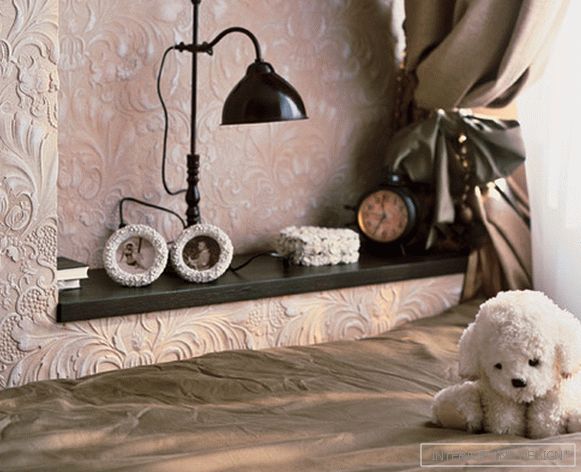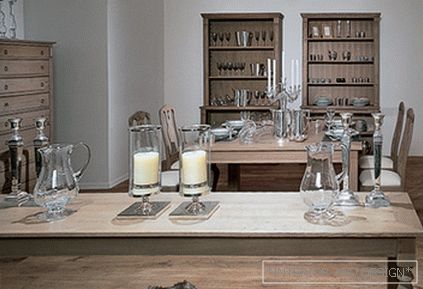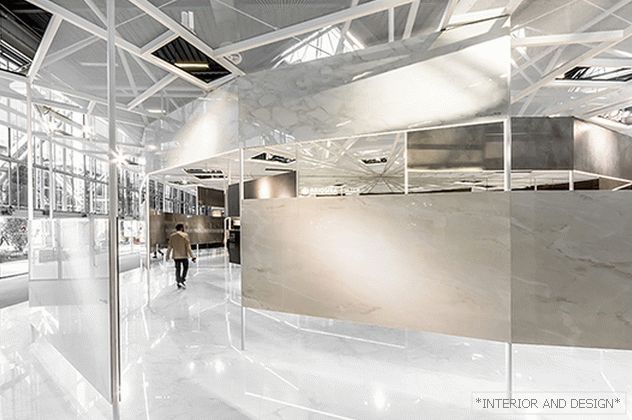 The natural reservoir at the dacha is a gift, but very few can boast about it. For those who do not have such a natural landscape, an artificial pond will be a great option. In hot weather, it will humidify the air, create a favorable climate for floristics, and, in general, bring a touch of freshness to the design of the garden.
The natural reservoir at the dacha is a gift, but very few can boast about it. For those who do not have such a natural landscape, an artificial pond will be a great option. In hot weather, it will humidify the air, create a favorable climate for floristics, and, in general, bring a touch of freshness to the design of the garden.
But what about a romantic evening to sit near such a pond. From the general concept of landscape design will depend not only the appearance and shape of the pond, but also the materials from which it will be made. For example, in areas with a large number of curvilinear bends, a free-form pond will look beautiful, and landscapes with consistent geometric shapes should also correspond to the shape of a reservoir.
Content
- 1 Types of country reservoirs
- 2 Materials for pond
- 3 How to create an artificial pond
- 4 Video instruction on the arrangement of the pond
Types of country reservoirs
Depending on the shape of the ponds can be divided into:
- geometric;
- irregular shape.
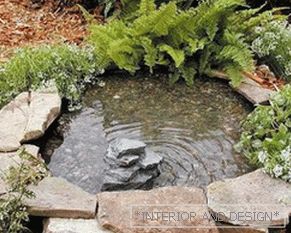 The first type is characterized by the correct forms. May have a trapezoid, circle, rectangle shape
The first type is characterized by the correct forms. May have a trapezoid, circle, rectangle shape
The ponds of the second type have the maximum similarity with natural reservoirs. They indicate arbitrary shapes and smooth outlines. The most popular forms oval and beans with the wrong line of the shore, which is planted with marsh plants. Such reservoirs will look great in the depths of the garden or on the edge of the lawn. On arrangement this pond practically does not differ from the first species.
The construction of the pond in the country on the water level can be:
- recessed;
- raised up.
The device of the buried pond provides for excavation and the use of special waterproofing materials. In such a pond, you can breed fish, subject to the presence of a wintering pit - a recess below the freezing level of the pond.
Raised ponds have a regular geometric shape and are created with the purpose of decorating the suburban area. The very name of these ponds indicates that they are elevated above ground level. It is impossible to breed fish in them, since in winter they freeze through completely. For the arrangement of such a pond does not need to dig a pit and remove the soil. It is somewhat easier to care for such ponds, which is more acceptable for people of the age.
Materials for the reservoir
Often the size of the pond is determined by the availability of free space, but it is much easier to build ecosystems in a large pond. Small pond will have to be cleaned much more often.
The pond at the dacha is located in an open, non-windy place. If you create a pond near the trees, you have to to fight with fallen leaves and roots, striving to damage the bed of the pond. Also, when choosing a place, you should take into account the time period of exposure to sunlight. It should not exceed 10 hours, the most optimal - 6 o'clock. If the sun's rays fall on the water more than the specified time, green algae and bacteria will actively develop in it.
 To create a man-made reservoir, you can use a finished bowl of reinforced plastic or fiberglass, polyvinyl chloride or butyl rubber film, or make a pond of reinforced concrete.
To create a man-made reservoir, you can use a finished bowl of reinforced plastic or fiberglass, polyvinyl chloride or butyl rubber film, or make a pond of reinforced concrete.
Of course, the quickest way is to use fiberglass containers which can be of various shapes and sizes. But manufacturers are not pleased with the large quadrature of these bowls: no more than 4 m² with a depth of 50–80 cm. Capacities with more than 10 m² are expensive and more likely intended for the device of plastic basins. Depending on the characteristics and size of the price of capacity varies from 1−8 thousand rubles. Creating a pond using this material is to arrangement of the pit required size and installation of a bowl in it.
Through the use of butyl rubber or polyvinyl chloride film as insulation material, you can create a pond of any size that imitates a natural pond. Currently, the building materials market offers a wide selection of this material at a low price.
PVC film is flexible and has high strength. The term of its operation is 15 years, and the cost starts from 160 rubles / m2. The leader of waterproofing materials for the creation of reservoirs is butyl rubber film, which is well tolerated in both low and high temperatures, while not cracking. The service life of this material exceeds 1.5 years. However, the cost is almost twice as high - from 280 rubles per 1 square. m
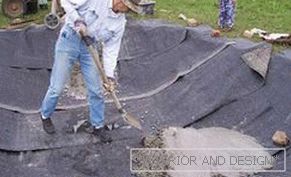 The record for operational life and reliability indicators among waterproofing materials for creating ponds is reinforced concrete. The bottom of plastic or plastic bowls can be damaged, but in order to break the concrete bottom it is necessary to make a lot of effort. At the same time and the process of creating a reservoir is complicated. The use of several layers of waterproofing, production of formwork and welding of reinforcement, plus the cost of concrete make such a pond a very expensive pleasure.
The record for operational life and reliability indicators among waterproofing materials for creating ponds is reinforced concrete. The bottom of plastic or plastic bowls can be damaged, but in order to break the concrete bottom it is necessary to make a lot of effort. At the same time and the process of creating a reservoir is complicated. The use of several layers of waterproofing, production of formwork and welding of reinforcement, plus the cost of concrete make such a pond a very expensive pleasure.
How to create an artificial pond
If the choice fell on hard bowl, the arrangement of the pond will be as follows. First, using a spade, you need to circle the contour of the upside-down bath. Further along this outline a excavation is dug out, which is made 4 cm deeper in the tank. The difference in depth is filled with sand, which prevents the container from sinking. If the bowl with terraces, you need to outline each of them and dig out in the desired sequence. Next action - putting the bowl in the pit and filling it with water. At each stage it is necessary to check the horizontal level of the surfaces by the construction level. The voids formed between the tank and the pit are also filled with sand. The edges of the bowl are faced with bricks or tiles. The final stage - placement at the bottom of the pond planted in a special fabric or mesh of aquatic plants.
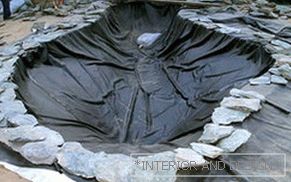 When creating a pond using PVC waterproofing or butyl rubber film, it is necessary to calculate its footage. To calculate the width of the film, the widths of the pit, two depth indicators and 60-centimeter allowances to secure the edges of the film. Similar to the calculation of the length of the film. If you need to connect several pieces of PVC film, you will need adhesive and adhesive tape from the same manufacturer. Apply mastic with further hot vulcanization to glue the butyl rubber film.
When creating a pond using PVC waterproofing or butyl rubber film, it is necessary to calculate its footage. To calculate the width of the film, the widths of the pit, two depth indicators and 60-centimeter allowances to secure the edges of the film. Similar to the calculation of the length of the film. If you need to connect several pieces of PVC film, you will need adhesive and adhesive tape from the same manufacturer. Apply mastic with further hot vulcanization to glue the butyl rubber film.
The first stage of creating the pond is the same: the shape of the future reservoir is outlined and the foundation pit is made. Next to the bottom of the pit is laid with subsequent ramming 3-5 cm washed sand. The sand surface is covered with geotextile, which prevents damage to the film. Then the film is laid and its edges are fixed with bricks or stones. To lay down the film and take the necessary form, water is supplied to its center. Planting material is regulated with the help of retaining stones.
A day later after the pond is completely filled, the excess film is cut off, only 25–30 cm remain, on which with the help of cement mortar a blind area not less than 60 cm wide is laid. The pond facing is made of brick, tile or stones.
To create an artificial pond using a concrete bowl can only be the correct geometric shape. The order of construction:
- The bottom and walls of the pit are covered with a layer of waterproofing - salt coatinglapped and lubricated with molten bitumen.
- Next lay out a layer of rubble and sand.
- Concrete is laid on top of the sand; reinforcing mesh.
- The second layer of concrete is laid out a week later. To prevent the concrete from cracking it is necessary to cover it with polyethylene wrap or wet sacking.
- Then, facing the bowl and the coastline with tiles, stones or bricks. Planted at the bottom of the plant and the tank is filled with water.
It should be remembered that such a pond during the season must be filled three times with water and completely drain it. 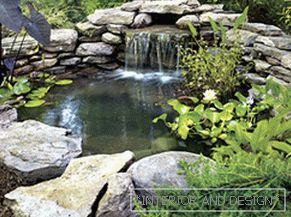 Florists recommend planting a pond to avoid water blooming that occurs when it overheats. oxygenator plantswhich will enrich water with oxygen. These plants, for example, include marsh, rogolodnik, Canadian elder. Plants with large leaves, such as capsules or water lilies, effectively solve the problem of overheating water.
Florists recommend planting a pond to avoid water blooming that occurs when it overheats. oxygenator plantswhich will enrich water with oxygen. These plants, for example, include marsh, rogolodnik, Canadian elder. Plants with large leaves, such as capsules or water lilies, effectively solve the problem of overheating water.
Before you begin to work on the creation of a reservoir, you need to think over everything from the location and shape to the number and varieties of plants. Then the pond will deliver aesthetic pleasure, and delight the owners and guests of the summer cottage with its freshness for a long time.

